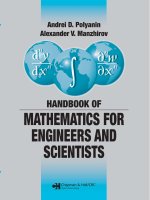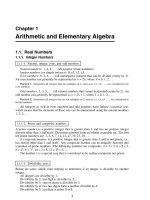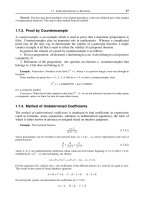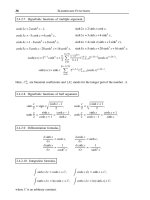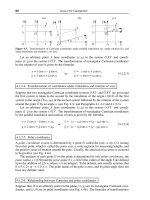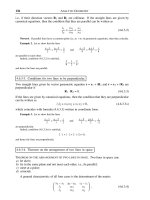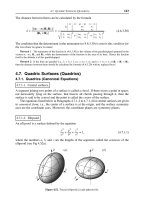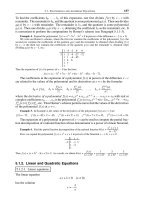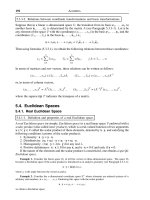Handbook of mathematics for engineers and scienteists part 8 pps
Bạn đang xem bản rút gọn của tài liệu. Xem và tải ngay bản đầy đủ của tài liệu tại đây (433.66 KB, 7 trang )
1.7. SOME MAT H E MAT I C A L METHODS 17
Remark. The first step, the formulation of an original hypothesis, is the most difficult part of the method
of mathematical induction. This step is often omitted from the method.
1.7.3. Proof by Counterexample
A counterexample is an example which is used to prove that a statement (proposition) is
false. Counterexamples play an important role in mathematics. Whereas a complicated
proof may be the only way to demonstrate the validity of a particular theorem, a single
counter example is all that is need to refute the validity of a proposed theorem.
In general, the scheme of a proof by counterexample is as follows:
1. Given a proposition: all elements a that belong to a set A also belong to a set (possess
a property) B.
2. Refutation of the proposition: one specifies an element a
∗
(counterexample) that
belongs to A but does not belong to B.
Example. Proposition: Numbers in the form 2
2
n
+ 1,wheren is a positive integer, were once thought to
be prime.
These numbers are prime for n = 1, 2, 3, 4.Butforn = 5, we have a counterexample, since
2
2
5
+ 1 = 4294967297 = 641 × 6700417;
it is a composite number.
Conclusion: When faced with a number in the form 2
2
n
+ 1, we are not allowed to assume it is either prime
or composite, unless we know for sure for some other reason.
1.7.4. Method of Undetermined Coefficients
The method of undetermined coefficients is employed to find coefficients in expressions
(such as formulas, series expansions, solutions to mathematical equations), the form of
which is either known in advance or assigned based on intuitive judgment.
Example. The fractional function
x + 2
x(x
2
– 1)
,(1.7.4.1)
whose denominator can be rewritten in the factored form x(x + 1)(x – 1), can be represented as the sum of
partial fractions
A
x
+
B
x + 1
+
C
x – 1
,(1.7.4.2)
where A, B, C are (undetermined) coefficients whose values are to be found. Equating (1.7.4.1) with (1.7.4.2),
multiplying by x(x
2
– 1), and rearranging, one obtains
(A + B + C)x
2
+(–B + C – 1)x – A – 2 = 0.
For this equation to be valid for any x, the coefficients of the different powers of x must be set equal to zero.
This results in the system of linear algebraic equations
A + B + C = 0, C – B – 1 = 0,–A – 2 = 0.
On solving this system, one determines the coefficients in (1.7.4.2):
A =–2, B =
1
2
, C =
3
2
.
18 ARITHMETIC AND ELEMENTARY ALGEBRA
References for Chapter 1
Bronshtein, I. N. and Semendyayev, K. A., Handbook of Mathematics, 4th Edition, Springer-Verlag, Berlin,
2004.
Courant, R. and Robbins, H., What Is Mathematics?: An Elementary Approach to Ideas and Methods, 2nd
Edition, Oxford University Press, Oxford, 1996.
Franklin, J. and Daoud, A., Introduction to Proofs in Mathematics, Prentice Hall, New York, 1988.
Garnier, R. and Taylor, J., 100% Mathematical Proof , John Wiley & Sons, New York, 1996.
Gelbaum, B. R. and Olmsted, J. M. H., Theorems and Counterexamples in Mathematics, Springer-Verlag,
New York, 1990.
Jordan,B.E.andPalow,W.P.,Integrated Arithmetic & Algebra, Addison-Wesley, Boston, 1999.
Krantz, S. G., Dictionary of Algebra, Arithmetic, and Trigonometry, CRC Press, Boca Raton, 2001.
P
´
olya, G., Mathematics and Plausible Reasoning, Vol. 1: Induction and Analogy in Mathematics, Princeton
University Press, Princeton, 1990.
Rossi, R. J., Theorems, Corollaries, Lemmas, and Methods of Proof , Wiley-Interscience, Hoboken, N.J., 2006.
Thompson, J. E., Arithmetic for the Practical Man, Van Nostrand Reinhold, New York, 1973.
Weisstein, E. W., CRC Concise Encyclopedia of Mathematics, 2nd Edition, CRC Press, Boca Raton, 2003.
Zwillinger, D., CRC Standard Mathematical Tables and Formulae, 31st Edition, CRC Press, Boca Raton, 2002.
Chapter 2
Elementary Functions
Basic elementary functions: power, exponential, logarithmic, trigonometric, and inverse
trigonometric (arc-trigonometric or antitrigonometric) functions. All other elementary
functions are obtained from the basic elementary functions and constants by means of
the four arithmetic operations (addition, subtraction, multiplication, and division) and the
operation of composition (composite functions).
The graphs and the main properties of the basic as well as some other frequently
occurring elementary functions of the real variable are described below.
2.1. Power, Exponential, and Logarithmic Functions
2.1.1. Power Function: y = x
α
(α is an Arbitrary Real Number)
2.1.1-1. Graphs of the power function.
General properties of the graphs: the point (1, 1) belongs to all the graphs, and y > 0 for
x > 0.Forα > 0, the graphs pass through the origin (0, 0); for α < 0, the graphs have the
vertical asymptote x = 0 (y → +∞ as x → 0, x > 0). For α = 0, the graph is a straight line
parallel to the x-axis.
Consider more closely the following cases.
Case 1: y = x
2n
,wheren is a positive integer (n = 1, 2, ). This function is defined
for all real x and its range consists of all y ≥ 0. This function is even, nonperiodic, and
unbounded. It crosses the axis Oy and is tangential to the axis Ox at the origin x = 0, y = 0.
On the interval (–∞, 0) this function decreases, and it increases on the interval (0,+∞). It
attains its minimum y = 0 at x = 0. The graph of the function y = x
2
(parabola) is given in
Fig. 2.1 a.
Case 2: y = x
2n+1
,wheren is a positive integer. This function is defined on the entire
x-axis and its range coincides with the y-axis. This function is odd, nonperiodic, and
unbounded. It crosses the x-axis and the y-axis at the origin x = 0, y = 0. It is an increasing
function on the entire real axis with no points of extremum, the origin being its inflection
point. The graph of the function y = x
3
(cubic parabola) is shown in Fig. 2.1 a.
Case 3: y = x
–2n
,wheren is a positive integer. This function is defined for all x ≠ 0,
and its range is the semiaxis y > 0. It is an even, nonperiodic, unbounded function having
no intersection with the coordinate axes. It increases on the interval (–∞, 0), decreases on
the interval (0,+∞), and has no points of extremum. This function has a vertical asymptote
x = 0. The graph of the function y = x
–2
is given in Fig. 2.1 b.
Case 4: y = x
–2n+1
,wheren is a positive integer. This function is defined for all x ≠ 0,
and its range is the entire y-axis. It is an odd, nonperiodic, unbounded function with no
intersections with the coordinate axes. This is a decreasing function on the entire real axis
with no points of extremum. It has a vertical asymptote x = 0. The graph of the function
y = x
–1
isgiveninFig.2.1b.
19
20 ELEMENTARY FUNCTIONS
OO1112
11
22
132
11
22
33
x
yx=
yx=
yx=
yx=
2
2
1
3
x
yy
()a ()b
Figure 2.1. Graphs of the power function y = x
n
,wheren is an integer.
Case 5: y = x
α
with a noninteger α > 0. This function is defined for all* x ≥ 0 and
its range is the semiaxis y ≥ 0. This function is neither odd nor even and it is nonperiodic
and unbounded. It crosses the axes Ox and Oy at the origin x = 0, y = 0 and increases
everywhere in its domain, taking its smallest value at the limit point x = 0, y = 0. The graph
of the function y = x
1/2
isgiveninFig.2.2.
O 12345
1
2
3
4
x
y
yx=
yx=
1/2
1/2
Figure 2.2. Graphs of the power function y = x
α
,whereα is a noninteger.
Case 6: y = x
α
with a noninteger α < 0. This function is defined for all x ≥ 0 and its
range is the semiaxis y ≥ 0. This function is neither odd nor even, it is nonperiodic and
unbounded, and it has no intersections with the coordinate axes, which coincide with its
horizontal and vertical asymptotes. This function is decreasing on its entire domain and has
no points of extremum. The graph of the function y = x
–1/2
isgiveninFig.2.2.
* In fact, the power function y = x
1/n
with an odd integer n is defined and negative for all x < 0. Here,
however, it is always assumed that x ≥ 0. A similar assumption is made with regard to the functions of the
form y = x
m/n
,wherem is a positive integer and m/n is an irreducible fraction.
2.1. POWER,EXPONENTIAL, AND LOGARITHMIC FUNCTIONS 21
2.1.1-2. Properties of the power function.
Basic properties of the power function:
x
α
x
β
= x
α+β
,(x
1
x
2
)
α
= x
α
1
x
α
2
,(x
α
)
β
= x
αβ
,
for any α and β,wherex > 0, x
1
> 0, x
2
> 0.
Differentiation and integration formulas:
(x
α
)
= αx
α–1
,
x
α
dx =
x
α+1
α + 1
+ C if α ≠ –1,
ln |x| + C if α =–1.
The Taylor series expansion in a neighborhood of an arbitrary point:
x
α
=
∞
n=0
C
n
α
x
α–n
0
(x – x
0
)
n
for |x – x
0
| < |x
0
|,
where C
n
α
=
α(α – 1) (α – n + 1)
n!
are binomial coefficients.
2.1.2. Exponential Function: y = a
x
(a >0, a ≠ 1)
2.1.2-1. Graphs of the exponential function.
This function is defined for all x and its range is the semiaxis y > 0. This function is neither
odd nor even, it is nonperiodic and unbounded, and it crosses the axis Oy at y = 1 and
does not cross the axis Ox.Fora > 1, it is an increasing function on the entire real axis;
for 0 < a < 1, it is a decreasing function. This function has no extremal points; the axis
Ox is its horizontal asymptote. The graphs of these functions have the following common
property: they pass through the point (0, 1). The graph of y = a
x
is symmetrical to the
graph of y =(1/a)
x
with respect to the y-axis. For a > 1, the function a
x
grows faster than
any power of x as x → +∞, and it decays faster than any power of 1/x as x → –∞.The
graphs of the functions y = 2
x
and y =(1/2)
x
are given in Fig. 2.3.
O
1
2
3
4
x
y =2
y =2
y
1
3
212
x
x
Figure 2.3. Graphs of the exponential function.
22 ELEMENTARY FUNCTIONS
2.1.2-2. Properties of the exponential function.
Basic properties of the exponential function:
a
x
1
a
x
2
= a
x
1
+x
2
, a
x
b
x
=(ab)
x
,(a
x
1
)
x
2
= a
x
1
x
2
.
Number e, base of natural (Napierian) logarithms, and the function e
x
:
e = lim
n→∞
1 +
1
n
n
= 2.718281 , e
x
= lim
n→∞
1 +
x
n
n
.
The formula for passing from an arbitrary base a to the base e of natural logarithms:
a
x
= e
x ln a
.
The inequality
a
x
1
> a
x
2
⇐⇒
x
1
> x
2
if a > 1,
x
1
< x
2
if 0 < a < 1.
The limit relations for any a > 1 and b > 0:
lim
x→+∞
a
x
|x|
b
= ∞, lim
x→–∞
a
x
|x|
b
= 0.
Differentiation and integration formulas:
(e
x
)
= e
x
,
e
x
dx = e
x
+ C;
(a
x
)
= a
x
ln a,
a
x
dx =
a
x
ln a
+ C.
The expansion in power series:
e
x
= 1 +
x
1!
+
x
2
2!
+
x
3
3!
+ ···+
x
n
n!
+ ··· =
∞
k=0
x
k
k!
.
2.1.3. Logarithmic Function: y = log
a
x (a >0, a ≠ 1)
2.1.3-1. Graphs of the logarithmic function.
This function is defined for all x > 0 and its range is the entire y-axis. The function is
neither odd nor even; it is nonperiodic and unbounded; it crosses the axis Ox at x = 1 and
does not cross the axis Oy.Fora > 1, this function is increasing, and for 0 < a < 1,itis
a decreasing function; it has no extremal points, and the axis Oy is its vertical asymptote.
The common property of the graphs of such functions is that they all pass through the point
(1, 0). The graph of the function y =log
a
x is symmetric to that of y =log
1/a
x with respect
to the x-axis. The modulus of the logarithmic function tends to infinity slower than any
power of x as x → +∞; and it tends to zero slower than any power of 1/x as x → +0.The
graphs of the functions y =log
2
x and y =log
1/2
x are shown in Fig. 2.4.
2.1. POWER,EXPONENTIAL, AND LOGARITHMIC FUNCTIONS 23
O 123456
x
yx= log
yx= log
2
1/2
y
1
2
1
2
Figure 2.4. Graphs of the logarithmic function.
2.1.3-2. Properties of the logarithmic function.
By definition, the logarithmic function is the inverse of the exponential function. The
following equivalence relation holds:
y =log
a
x ⇐⇒ x = a
y
,
where a > 0, a ≠ 1.
Basic properties of the logarithmic function:
a
log
a
x
= x,log
a
(x
1
x
2
)=log
a
x
1
+log
a
x
2
,
log
a
(x
k
)=k log
a
x,log
a
x =
log
b
x
log
b
a
,
where x > 0, x
1
> 0, x
2
> 0, a > 0, a ≠ 1, b > 0, b ≠ 1.
The simplest inequality:
log
a
x
1
>log
a
x
2
⇐⇒
x
1
> x
2
if a > 1,
x
1
< x
2
if 0 < a < 1.
For any b > 0, the following limit relations hold:
lim
x→+∞
log
a
x
x
b
= 0, lim
x→+0
x
b
log
a
x = 0.
The logarithmic function with the base e (base of natural logarithms, Napierian base)
is denoted by
log
e
x =lnx,
where e = lim
n→∞
1 +
1
n
n
= 2.718281
Formulas for passing from an arbitrary base a to the Napierian base e:
log
a
x =
ln x
ln a
.
Differentiation and integration formulas:
(ln x)
=
1
x
,
ln xdx= x ln x – x + C.
Expansion in power series:
ln(1 + x)=x –
x
2
2
+
x
3
3
– ···+(–1)
n–1
x
n
n
+ ··· =
∞
k=1
(–1)
k–1
x
k
k
,–1 < x < 1.
